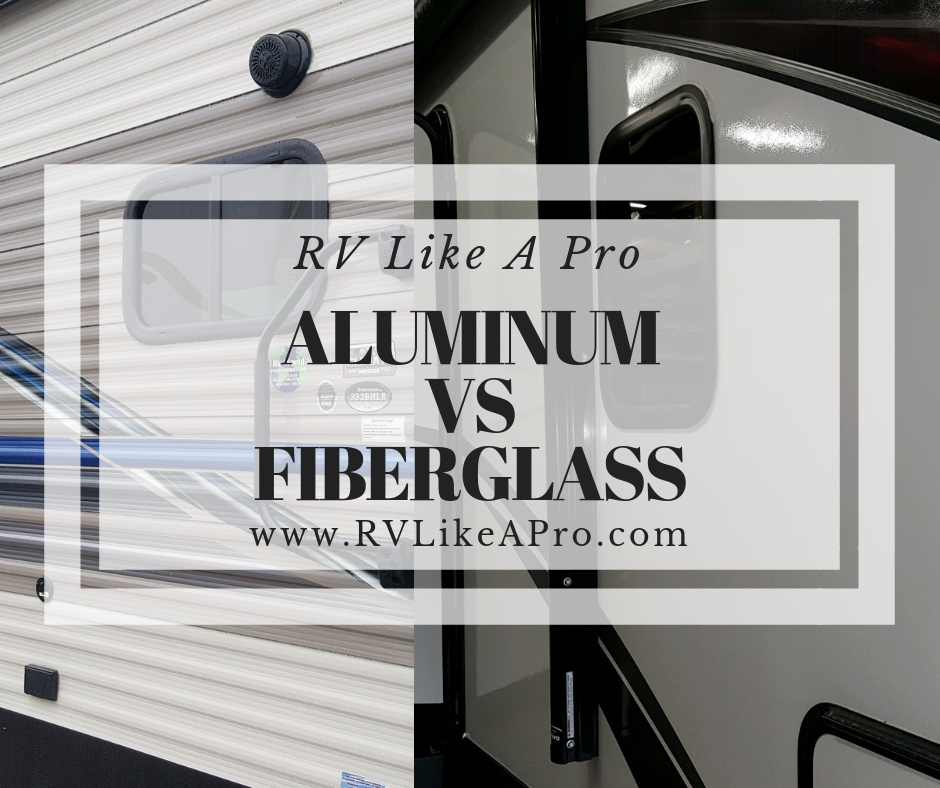
Aluminum vs Fiberglass Siding
One question people always ask me is: “What is the difference between aluminum siding and fiberglass siding on an RV?” This article will teach you some of the advantages, disadvantages, and differences.
The easiest way to tell the difference between aluminum siding and fiberglass siding is that aluminum is usually wavy (but not always). Fiberglass siding is usually smooth.
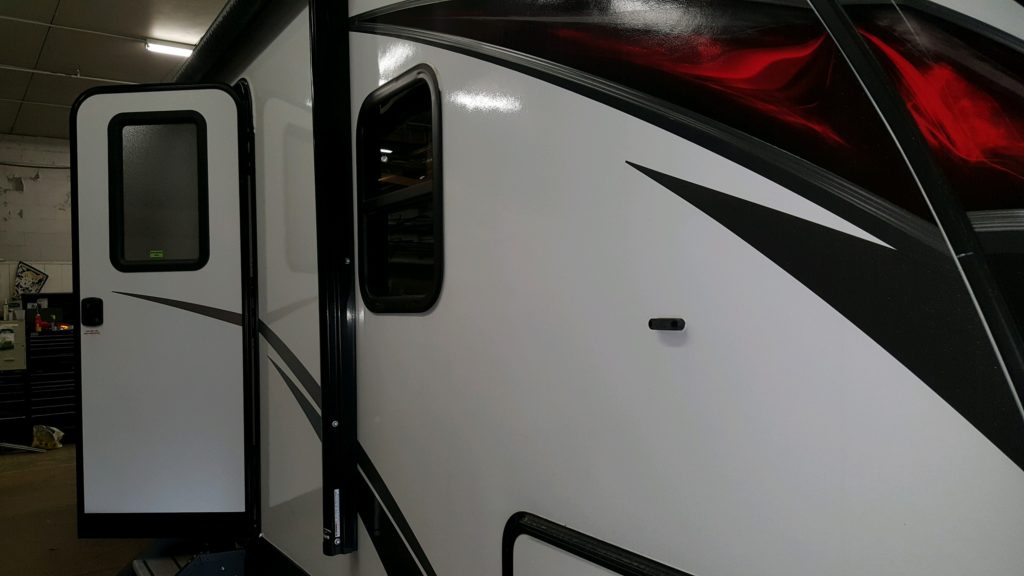
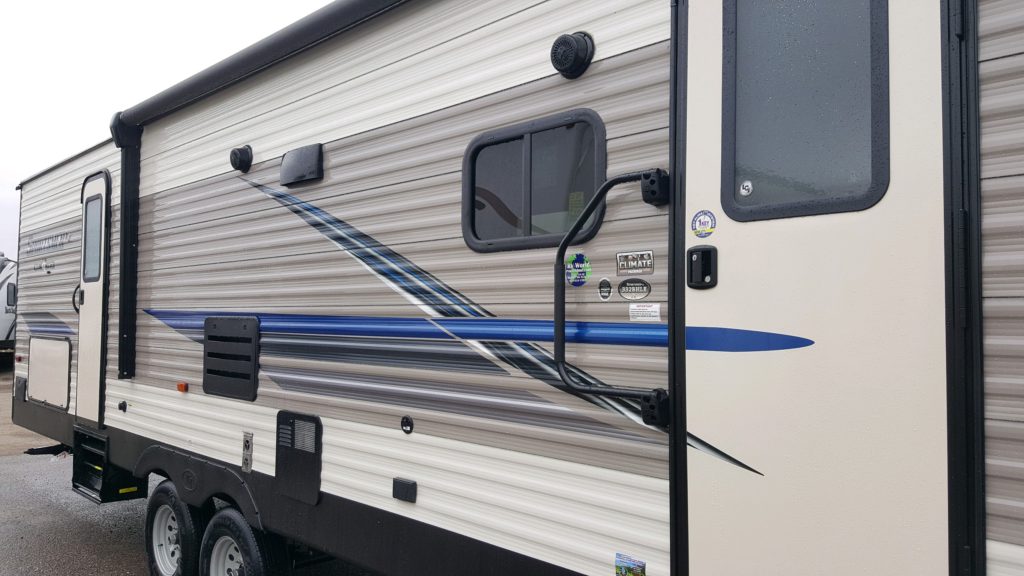
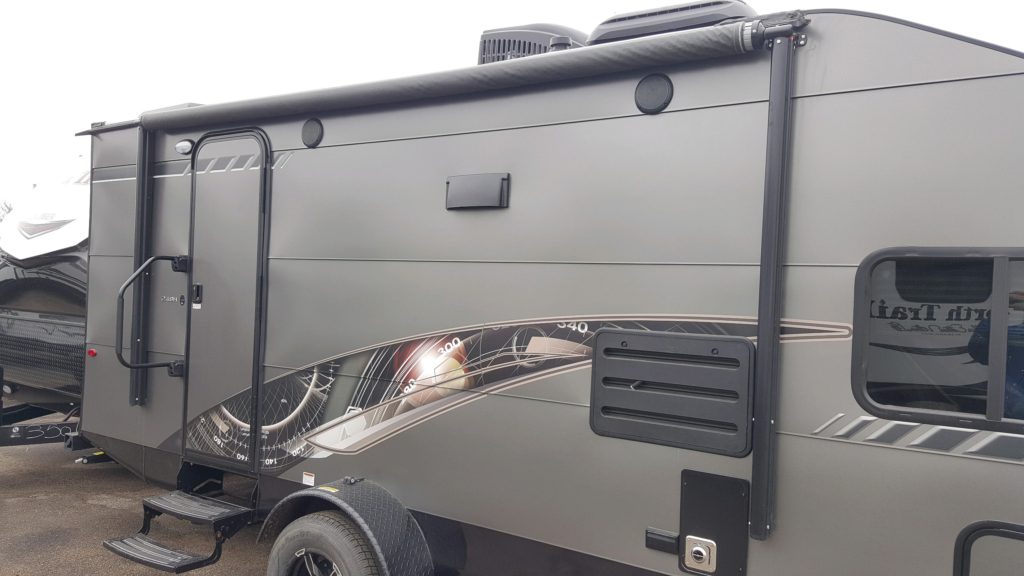
Aluminum Siding
Aluminum sided campers usually have wood frames in their walls. That’s because the aluminum is stapled to the wood studs. They are also usually insulated with fiberglass insulation. Inside the RV is a panel stapled to the wall that you see on the interior of the camper.
Advantages
- Usually aluminum campers are much less expensive. An aluminum sided camper can be thousands less expensive than its fiberglass twin. If you have an accident, with an aluminum sided camper, you may be able replace the one or two damaged panels by yourself.
- The exterior walls on an aluminum sided camper are hollow. This means running cables and wires is much easier.
- Wood framing does not transfer heat and cold through the wall as quickly as aluminum framing.
- Tried and true. It has been around for MANY years an it is not going anywhere.
Disadvantages
- Water damage if you do not properly inspect the silicone on the side or roof corners of your camper and you develop a leak.
- Water will run down the inside of the wall and can then rot your walls and floor. It can take many months before the leak is discovered causing significant damage and a costly repair.
- In older aluminum sided campers, the batt insulation could fall down inside the wall leaving an air gap at the top of the wall. This means that the camper may not hold temperature as well (you will lose heat quickly in colder temperature). Newer campers do glue the insulation in place on each side of the batt insulation. However there still could be insulation gaps.
- Hail damages aluminum siding pretty quickly. However, insurance may cover it.
Fiberglass Siding
Fiberglass is attached to either Lauan wood or in some newer campers Azdale. Azdale is a woven fiberglass / plastic product that does not absorb water. The siding is glued to the aluminum frame and foam block insulation. The interior paneling is then glued to the inside of the foam block insulation.
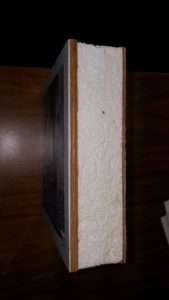
Advantages
- If you do not properly inspect your silicone and you develop a leak.
- Water can infiltrate your walls but will not run down to the floor and rot your floor due to the foam block insulation and glue.
- Fiberglass walls are generally quieter. Keeping sound out or in.
- There is often less flex in fiberglass walls.
- There are not staples on the exterior walls.
- Better looking walls with less putty usage.
- There are no wires ran in exterior walls, the walls are solid.
- Usually easier to clean.
- Hail does not damage fiberglass like aluminum.
- Fiberglass is generally a little more durable to hits or dents.
- Fiberglass does tend to look better a little longer and hold its resale value.
- Campers that have the fiberglass affixed to Azdale may not experience as much fiberglass de-lamination.
- Azdale does not absorb water. Adale has only been around a limited number of years and a lot of manufacturers do not use it due to its price.
Disadvantages
- If water gets inside the walls due to an exterior leak de-lamination of the fiberglass can occur.
- This is a very real problem in older RVs. If considering buying a fiberglass RV or camper inspect it very closely for waves, bubbles or flaws. A lot of fiberglass walls have this problem. The buyer also needs to inspect the inside walls especially near the corners and under windows. Because the water cannot run down the inside of the wall it may run down the outside of the wall causing the paneling to peel. De-lamination often occurs from water penetrating the wall however could be just as simple as the glue let loose between the fiberglass and the Lauan wood. De-lamination is very expensive to repair, sometimes the entire wall needs to be replaced.
- The RV owner cannot run wires through the walls making satellite cables difficult to run.
- If something strikes the the fiberglass wall. Spiderweb like cracks can occur, being very expensive to repair.
- Fiberglass is much more expensive to fix if in an accident. The typical RVer cannot repair this themselves.
- When a tree branch is drug along the side of a fiberglass sided RV it’s very easy to notice the scrape marks.
- The rear and front walls of a fiberglass RV are not vacuum bonded or pinch rolled and glued. This allows for camper flexibility. In the case of the camper below there was a very thin layer of fiberglass which was glued to cardboard and then attached to the wood frame walls only by the edges, the window pinching it and the ladder being attached to the back end. Once that cardboard became wet the wall look terrible. The entire back wall needed to be rebuilt.
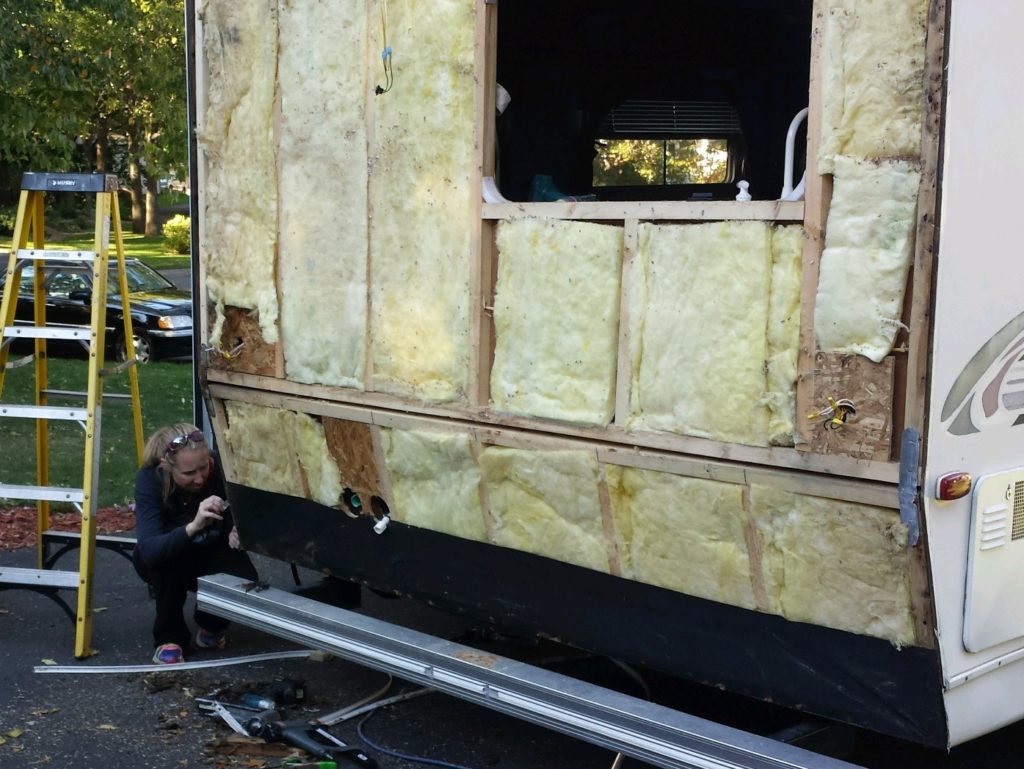
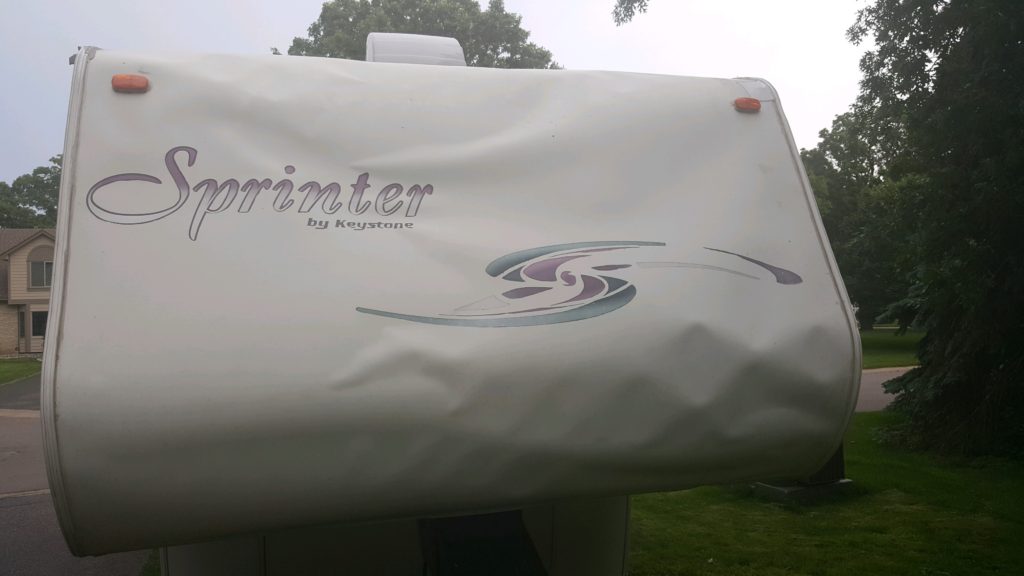
Conclusion
Fiberglass wins hands-down in durability, shine and cleanliness. However aluminum sided campers have been, and will be, around forever. In my opinion it’s a matter of what the buyer prefers. This is especially true if cost is not an issue.
Some people believe aluminum sided Campers are lighter then fiberglass sided campers this is not usually true. The aluminum is stapled to wood which is fairly heavy. Fiberglass sided campers are generally glued to aluminum framing and solid foam insulation. The weight difference between aluminum sided and fiberglass sided trailers is minimal.
Some people also believe aluminum is not as aerodynamic as fiberglass and fiberglass sided campers will get better gas mileage. I don’t believe there’s a big enough difference to make that a factor when and considering purchasing your next RV.
On a side note. Do not use a pressure washer to wash your camper unless you’re keeping it far back from the camper. Using a pressure washer can drive water beneath your Silicone and remove your decals. I recommend blue Dawn dish soap and a soft brush. For tough stains use black streak remover or bug remover.
Hopefully now you are at least a little more educated on fiberglass vs aluminum sided campers. As with most things regarding an RV it is really up the the buyer and what they prefer.
Happy Camping!


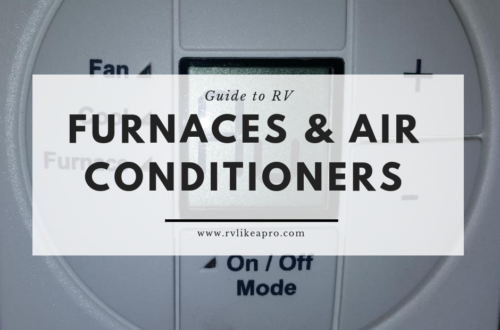
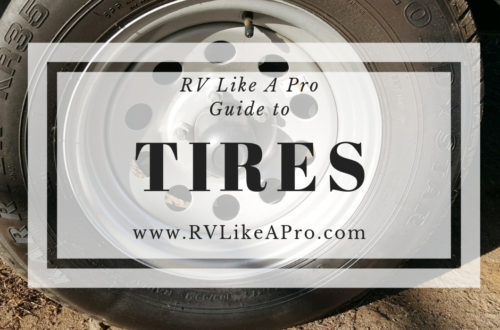
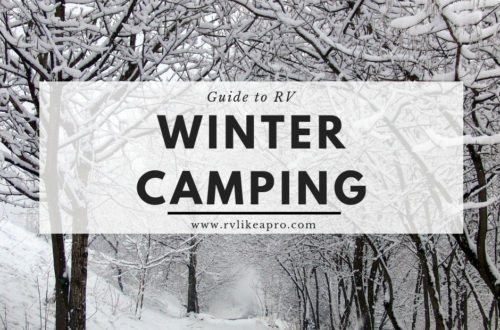
27 Comments
Holly Bird
Thank you so much for all this info, I have been looking and been leaning to fiberglass, now I know that is the way I want to go!!
Amber Neil
We camp in our trailer over 100 days a year and I completely agree fiber glass for the win! All day every day!
Laura
I’m so jealous of your RV Life. I’m definitely reading your post on buying an RV. Thanks for the great info!
Laura Follett
I want to live in an RV and travel the country! My husband on the other hand, isn’t too keen on the idea! I’ll have to remember this for when I finally convince him! HaHa!
Jill
I didn’t even know there was a difference. Our friends have an RV that we’ve stayed in and it was a lot of fun!
angela
I never thought about all this before and my husband and I are thinking of getting a travel trailer. I am not sure what my husband thinks about these two but I will have him read this too so we can make a good decision.
Tricia Snow
This is a really great comparison. I had an aluminum horse trailer with living quarters. A detailer acid washed it and ruined the paint. Terrible decision!
Kyndall Bennett
It’s awesome that you can break down so many key components of RVs! I wouldn’t know what to look for at all! 😅
Kristi @ Way Beyond The Norm
My hubby agrees with your conclusion! Fiberglass is what we have. So far so good. Thanks for sharing all of your RV tips with us!
Malia
Very comprehensive comparison. Thank you for including the picture of delamination. I appreciate the soundproofing of fiberglass, and ease of cleaning!
Leigh Ann
Wow! I had no idea about all of this. You always share such great and informative content.
Lisa Manderino
Very Interesting, Lots of good information, I like the way the fiberglass looks better!
Heather
I don’t have an RV or even camp, but your posts are great. You give such useful information. Thanks for sharing!
Charlene
I never knew there was so much to know about RV camping!
Michelle
Great information! I would not have thought about the damage a pressure washer could potentially do! Thanks for sharing.
jen
I always learn so much from you posts.
Pauline
Thank you for these great tips. We have had both and there are pros in cons for both. We preferred fiber glass for when we had to live in one due to transitioning between states and prefer the aluminum for when we take it camping in the woods because its easier to fix and durable for narrow dirt roads.
Lina
Thanks for this wonderful post! I never knew there was so much to know about RV. We have been contemplating for years to get one but never really looked into what it entailed.
Cindy
Your posts are always so educational and helpful! If I ever own an RV I will know exactly what to look for and how to maintain it.
Liza
Your reviews are so in depth. Thank you for considering all sides and compiling the info for us!
Brittany
Great information! I have some camper friends that I will be passing your site along to. Thanks!
Meagan
Great information!
Karla
I have never even thought of this. Good information
Dawnmarie @ EnjoyingtheDays
I have enjoyed reading about your educational posts over the months. Today I signed up for your newsletter and likes you on Facebook. Thank you for sharing your weakthbif knowledge.
Kim
Thanks for the comparison! I think if I were going to purchase an RV, I would go for the Aluminum. I like the idea that you can replace panels instead of having to repair the whole side. I learned that the hard way with my car!
Jennifer Morrison
I had no idea about the differences. It does sound like fiberglass would be the winner if it can be afforded. I must say again, I have learned so much reading your posts.
T.M. Brown
More fantastic information for me to tuck away in case we decided to ever go this route. I am also going to send this to a friend who has been considering purchasing an RV. I know she will find this very useful information.